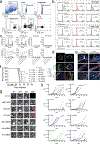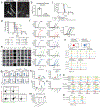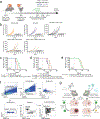VEGF-C-driven lymphatic drainage enables immunosurveillance of brain tumours
- PMID: 31942068
- PMCID: PMC7100608
- DOI: 10.1038/s41586-019-1912-x
VEGF-C-driven lymphatic drainage enables immunosurveillance of brain tumours
Erratum in
-
Publisher Correction: VEGF-C-driven lymphatic drainage enables immunosurveillance of brain tumours.Nature. 2021 Feb;590(7845):E34. doi: 10.1038/s41586-021-03204-z. Nature. 2021. PMID: 33500588 No abstract available.
Abstract
Immune surveillance against pathogens and tumours in the central nervous system is thought to be limited owing to the lack of lymphatic drainage. However, the characterization of the meningeal lymphatic network has shed light on previously unappreciated ways that an immune response can be elicited to antigens that are expressed in the brain1-3. Despite progress in our understanding of the development and structure of the meningeal lymphatic system, the contribution of this network in evoking a protective antigen-specific immune response in the brain remains unclear. Here, using a mouse model of glioblastoma, we show that the meningeal lymphatic vasculature can be manipulated to mount better immune responses against brain tumours. The immunity that is mediated by CD8 T cells to the glioblastoma antigen is very limited when the tumour is confined to the central nervous system, resulting in uncontrolled tumour growth. However, ectopic expression of vascular endothelial growth factor C (VEGF-C) promotes enhanced priming of CD8 T cells in the draining deep cervical lymph nodes, migration of CD8 T cells into the tumour, rapid clearance of the glioblastoma and a long-lasting antitumour memory response. Furthermore, transfection of an mRNA construct that expresses VEGF-C works synergistically with checkpoint blockade therapy to eradicate existing glioblastoma. These results reveal the capacity of VEGF-C to promote immune surveillance of tumours, and suggest a new therapeutic approach to treat brain tumours.
Conflict of interest statement
Competing Interests
Akiko Iwasaki, Eric Song, and Jean-Leon Thomas have filed a patent related to the manuscript as inventors. Application number, US 62/768,390; status of application, provisional; specific aspect of manuscript covered in patent application. Kari Alitalo is an inventor of several patents related to VEGF-C. He or his wife currently have no income, stock or other benefits from companies related to work in the manuscript. Helsinki University is a shareholder in companies related to the use of VEGF-C. Marcus Bosenberg is a consultant for Eli Lilly and Company.
Figures














Comment in
-
VEGF-C shines a light on brain tumours.Nat Rev Immunol. 2020 Mar;20(3):140-141. doi: 10.1038/s41577-020-0279-4. Nat Rev Immunol. 2020. PMID: 31969716 No abstract available.
-
VEGFC-Mediated Lymphatic Drainage Increases Brain Tumor Immunogenicity.Cancer Discov. 2020 Mar;10(3):OF3. doi: 10.1158/2159-8290.CD-RW2020-014. Epub 2020 Jan 24. Cancer Discov. 2020. PMID: 31980567
-
Meningeal lymphatics "drain" brain tumors.Cell Res. 2020 Mar;30(3):191-192. doi: 10.1038/s41422-020-0286-9. Cell Res. 2020. PMID: 32111971 Free PMC article. No abstract available.
-
Meningeal lymphatics prime tumor immunity in glioblastoma.Cancer Cell. 2021 Mar 8;39(3):304-306. doi: 10.1016/j.ccell.2021.02.012. Cancer Cell. 2021. PMID: 33689701 Free PMC article.
References
Publication types
MeSH terms
Substances
Grants and funding
- R01 AI127429/AI/NIAID NIH HHS/United States
- AI054359/NH/NIH HHS/United States
- P01 CA128814/CA/NCI NIH HHS/United States
- R01 CA196660/CA/NCI NIH HHS/United States
- CA128814/NH/NIH HHS/United States
- AI27429/NH/NIH HHS/United States
- CA196660/NH/NIH HHS/United States
- HHMI/Howard Hughes Medical Institute/United States
- T32 GM007205/GM/NIGMS NIH HHS/United States
- P50 CA121974/CA/NCI NIH HHS/United States
- F30 CA239444/CA/NCI NIH HHS/United States
- R01 EY025979/EY/NEI NIH HHS/United States
- R01EB016629-01/NH/NIH HHS/United States
- CA121974/NH/NIH HHS/United States
- R01 EY025979-01/NH/NIH HHS/United States
- R01 AI054359/AI/NIAID NIH HHS/United States
- R01 EB016629/EB/NIBIB NIH HHS/United States
LinkOut - more resources
Full Text Sources
Other Literature Sources
Medical
Molecular Biology Databases
Research Materials

